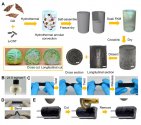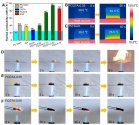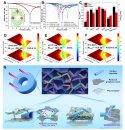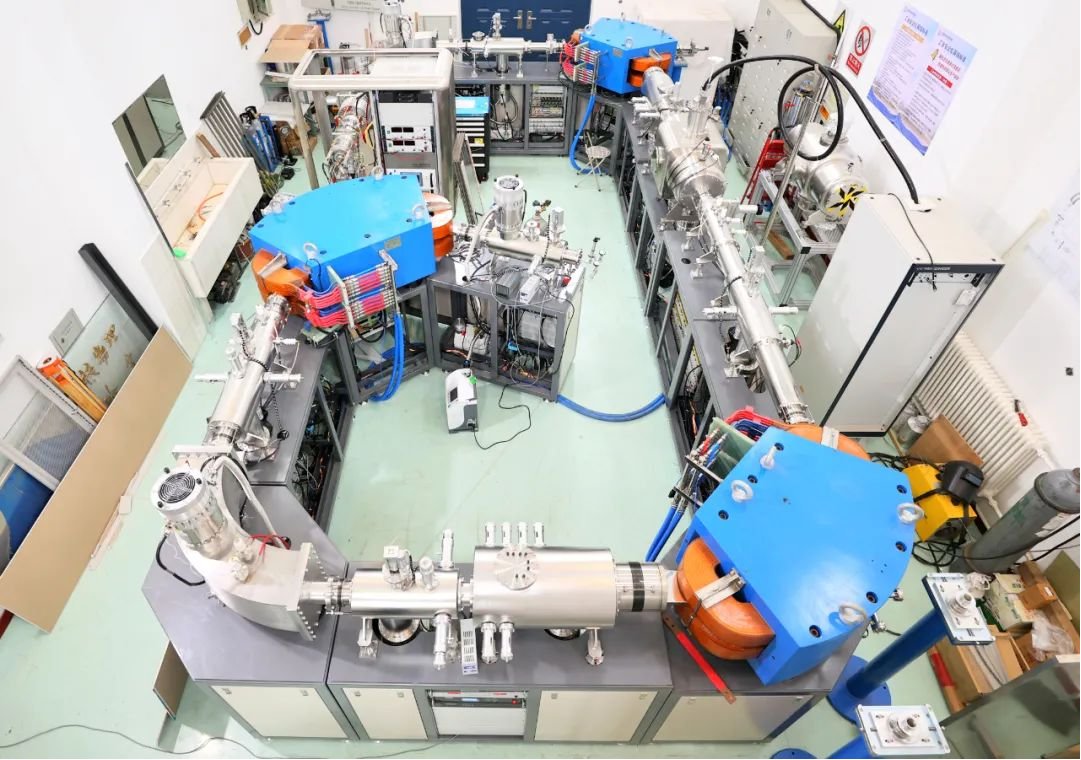You are using an out of date browser. It may not display this or other websites correctly.
You should upgrade or use an alternative browser.
You should upgrade or use an alternative browser.
News on China's scientific and technological development.
- Thread starter Quickie
- Start date
Soon after China has gained the production capacity of Molybdenum-100 isotope in kilograms, scientists from CAS is able to produce the Mo-99m isotope in high purity by using electron linear accelerator (linac) to shoot a target rich of Mo-100. So far China has to import 100% of its need of the Mo-99 isotope for clinical uses. Most of the clinical Mo-99 isotopes in the world have been created as a byproduct of U-235 fission reactions in nuclear reactors.
This experiment by CAS will help China overcome the shortage on the Mo isotopes when more and more commercial nuclear reactors around the global are being taken out of service. Making the Mo isotopes with linac also has less byproducts to remove in the end.
Paper:
News story:
近期,中国科学院近代物理研究所科研团队实现了利用电子加速器制备医用同位素钼-99。相关成果发表在国际同位素领域期刊《应用辐射与同位素》(Applied Radiation and Isotopes)上。
锝-99m(半衰期为6小时)在医疗诊断中被广泛使用,使用量占所有临床诊断放射性同位素使用量的80%以上,其来源主要依靠母体钼-99(半衰期为66小时)发生β-衰变。目前,我国医用钼-99全部依赖进口,而全球大部分的医用钼-99通过核反应堆途径,即铀-235裂变反应产生,但是随着越来越多的核反应堆停止运行,钼-99的供给也变得越发紧张。
为了保障全球医用同位素钼-99的稳定供应,国内外众多科研团队把目光投向利用加速器来制备钼-99。利用加速器辐照富集的稳定同位素钼-100,再通过光中子反应制备钼-99,这种方法具有副产物少、化学分离纯化简便等优势。
中国科学院近代物理研究所核化学研究室与电子加速器中心的科研人员于近日成功开展了制备钼-99的实验。团队利用蒙特卡罗方法,实现了靶系统的优化。他们先利用电子加速器产生的50兆电子伏电子束辐照钽转换靶,产生轫致辐射,再由轫致辐射与钼-100靶片发生光中子反应产生钼-99。
随后,研究团队使用了高纯锗探测器和伽马能谱仪测定了钼-99的产额以及放射性核纯度。实验表明,在使用该方法制备钼-99的过程中,产生的杂质核素水平较低,钼-99产品的放射性纯度可达99.99%。

This experiment by CAS will help China overcome the shortage on the Mo isotopes when more and more commercial nuclear reactors around the global are being taken out of service. Making the Mo isotopes with linac also has less byproducts to remove in the end.
Paper:
Optimization of target system for the production of 99Mo via 100Mo(γ,n)99Mo reaction
Abstract
With an increase of stopping operation of nuclear reactors worldwide, the supply of medical 99Mo becomes difficult and thus many efforts have been made to find an alternative. A process based on an electron (linac) system and a100Mo target via the 100Mo (γ,n)99Mo reaction receives a lot of attention due to the relatively low level of co-produced impurities. This process has been recently developed at the Institute of Modern (IMP) and the Monte Carlo simulation was used to optimize the target system before operating pilot irradiation experiments. First, tungsten and tantalum, as mostly used converter materials, were tested. The yield of 99Mo was evaluated with respect to the converter thickness and the energy by means of Geant4 simulations. Besides, the specific activity of 99Mo produced from one-stage approach (100Mo target without a converter) and two-stage approach (100Mo target with a converter) was compared when varying the testing conditions. The two-stage approach was selected for the experiment due to the higher specific activity of produced 99Mo at all tested conditions. A target consisting of a 10 mm thickness of the 100Mo tablets and a 2.4 mm thick Ta converter was irradiated for 40 h (50 MeV with 0.2 μA). The Geant4-calculated specific activity of generated 99Mo at the end of bombardment agreed well with the experimental value, which proved high level of accuracy of the Geant4 simulation. In future studies, the Geant4 simulation will be used to optimize the production process when using high power linac system.News story:
近期,中国科学院近代物理研究所科研团队实现了利用电子加速器制备医用同位素钼-99。相关成果发表在国际同位素领域期刊《应用辐射与同位素》(Applied Radiation and Isotopes)上。
锝-99m(半衰期为6小时)在医疗诊断中被广泛使用,使用量占所有临床诊断放射性同位素使用量的80%以上,其来源主要依靠母体钼-99(半衰期为66小时)发生β-衰变。目前,我国医用钼-99全部依赖进口,而全球大部分的医用钼-99通过核反应堆途径,即铀-235裂变反应产生,但是随着越来越多的核反应堆停止运行,钼-99的供给也变得越发紧张。
为了保障全球医用同位素钼-99的稳定供应,国内外众多科研团队把目光投向利用加速器来制备钼-99。利用加速器辐照富集的稳定同位素钼-100,再通过光中子反应制备钼-99,这种方法具有副产物少、化学分离纯化简便等优势。
中国科学院近代物理研究所核化学研究室与电子加速器中心的科研人员于近日成功开展了制备钼-99的实验。团队利用蒙特卡罗方法,实现了靶系统的优化。他们先利用电子加速器产生的50兆电子伏电子束辐照钽转换靶,产生轫致辐射,再由轫致辐射与钼-100靶片发生光中子反应产生钼-99。
随后,研究团队使用了高纯锗探测器和伽马能谱仪测定了钼-99的产额以及放射性核纯度。实验表明,在使用该方法制备钼-99的过程中,产生的杂质核素水平较低,钼-99产品的放射性纯度可达99.99%。
Carbon aerogels are excellent at thermal insulation and microwave absorption but are structurally fragile, therefore have limited practical applications.
South China University of Technology created a carbon aerogel with negative Poisson's ratios (aka anti-rubber). It is made from carbon nanotube and graphene oxide with "cabbage-like" structure and coated in fluororubber. It's highly flexible and compressible, fire resistent while keeping the thermal insulation and microwave absorption capabilities.
Paper:
Carbon aerogels have excellent heat resistance and electrical conductivity, but their poor structural integrity significantly limits their applications. We design a stable carbon nanotube (CNT)/graphene oxide (GO)-based carbon aerogel with a “cabbage-like” structure that is created through initial hydrogel formation via hydrothermal annular convection to realize the self-assembly of GO nanosheets and CNTs, followed by freeze drying of the hydrogel. The formed carbon aerogel is subsequently modified by a fluororubber solution to achieve both physical coating and hydrogen bonding between the thin fluororubber film and the aerogel. Thanks to the unique cabbage-like architecture and porous structure stabilized and protected by the fluororubber film, the resultant fluororubber/carbon aerogel (FCGA) hybrids possess unique mechanical properties, including negative Poisson’s ratios during compression and superior compressibility. Besides, FCGA hybrids have a low thermal conductivity, outstanding fire resistance, and exceptional microwave-absorption performance. Therefore, FCGA hybrids are promising for applications in flexible/wearable electronics, microwave absorption, etc.
具有类“卷心菜”结构的负泊松比碳气凝胶复合材料
近日,华南理工大学郭建华教授/康涅狄格大学孙陆逸教授团队报道了一种具有良好的柔韧性和负泊松比特性的复合碳气凝胶材料。该材料具有类卷心菜结构,表现出良好的柔韧性,耐切割性,优异的防火隔热和微波吸收性能。
相关成果Cabbage-like flexible fluororubber/carbon aerogel hybrids with negative Poissons ratios and excellent microwave absorption发表在2023年11月2日的Matter期刊上。论文通讯作者是郭建华教授和孙陆逸教授,第一作者为华南理工大学生余池,该工作的模拟仿真工作得到了华南理工大学胡楠教授团队的大力支持。
碳气凝胶是以碳纳米材料为骨架,具有三维多孔结构的凝胶材料。碳气凝胶由于具有极低的密度、良好的耐热性和导电性等优异性能被广泛关注和研究。目前,碳气凝胶在传感、隔热、防火、污水处理、储能和电磁吸收等诸多领域具有广阔的应用前景。然而碳气凝胶自身结构较为脆弱,力学性能不足限制了其在柔性传感器、可拉伸电子器件和航空航天等领域的应用。
在此,华南理工大学郭建华教授/康涅狄格大学孙陆逸教授团队通过设计制备了一种具有类卷心菜结构的氟橡胶改性碳气凝胶(FCGA),实现了碳气凝胶复合材料的可压缩回弹性和高柔韧性。该材料的制备过程是首先通过水热环流以及氧化石墨烯纳米片和碳纳米管的自组装,随后冷冻干燥制成碳气凝胶,之后再通过氟橡胶溶液对碳气凝胶进行浸渍改性,得到氟橡胶改性碳气凝胶(FCGA)。这种方法实现了氟橡胶薄膜和气凝胶之间的物理包覆和氢键结合,使得氟橡胶薄膜在碳气凝胶外部形成良好的保护。因而,制备的碳气凝胶复合材料具有优良的柔韧性和较低的负泊松比。
该研究工作通过Abaqus软件建模、模拟计算和3D打印制备聚氨酯模型样品,建立了FCGA的卷心菜结构与材料负泊松比性能之间的关联,揭示了负泊松比现象的形成机制,为负泊松比材料的结构设计提供了新思路。
此外,FCGA具有优异的防火和隔热性能,该气凝胶在1300 °C下火焰下不燃,而且材料的导热系数仅为40 mW•m−1•K−1,隔热性能好。FCGA的微波吸收性能优异,当厚度为3.1毫米时,复合气凝胶的微波吸收频带宽度为5.0 GHz,最小反射损耗达到−70.6 dB。
因此,该研究制备的新型碳气凝胶在多功能微波吸收材料、柔性电子元器件等领域具有潜在的应用前景。(来源:科学网)




South China University of Technology created a carbon aerogel with negative Poisson's ratios (aka anti-rubber). It is made from carbon nanotube and graphene oxide with "cabbage-like" structure and coated in fluororubber. It's highly flexible and compressible, fire resistent while keeping the thermal insulation and microwave absorption capabilities.
Paper:
Cabbage-like flexible fluororubber/carbon aerogel hybrids with negative Poisson’s ratios and excellent microwave absorption
Highlights
- CNT/GO carbon aerogels were fabricated by hydrothermal annular convection
- The brittle aerogels were toughened by chemical cross-linking and physical coating
- The aerogel hybrids with a cabbage-like structure show negative Poisson’s ratios
- The aerogel hybrids exhibit exceptional microwave-absorption performance
Summary
Carbon aerogels have excellent heat resistance and electrical conductivity, but their poor structural integrity significantly limits their applications. We design a stable carbon nanotube (CNT)/graphene oxide (GO)-based carbon aerogel with a “cabbage-like” structure that is created through initial hydrogel formation via hydrothermal annular convection to realize the self-assembly of GO nanosheets and CNTs, followed by freeze drying of the hydrogel. The formed carbon aerogel is subsequently modified by a fluororubber solution to achieve both physical coating and hydrogen bonding between the thin fluororubber film and the aerogel. Thanks to the unique cabbage-like architecture and porous structure stabilized and protected by the fluororubber film, the resultant fluororubber/carbon aerogel (FCGA) hybrids possess unique mechanical properties, including negative Poisson’s ratios during compression and superior compressibility. Besides, FCGA hybrids have a low thermal conductivity, outstanding fire resistance, and exceptional microwave-absorption performance. Therefore, FCGA hybrids are promising for applications in flexible/wearable electronics, microwave absorption, etc.
具有类“卷心菜”结构的负泊松比碳气凝胶复合材料
近日,华南理工大学郭建华教授/康涅狄格大学孙陆逸教授团队报道了一种具有良好的柔韧性和负泊松比特性的复合碳气凝胶材料。该材料具有类卷心菜结构,表现出良好的柔韧性,耐切割性,优异的防火隔热和微波吸收性能。
相关成果Cabbage-like flexible fluororubber/carbon aerogel hybrids with negative Poissons ratios and excellent microwave absorption发表在2023年11月2日的Matter期刊上。论文通讯作者是郭建华教授和孙陆逸教授,第一作者为华南理工大学生余池,该工作的模拟仿真工作得到了华南理工大学胡楠教授团队的大力支持。
碳气凝胶是以碳纳米材料为骨架,具有三维多孔结构的凝胶材料。碳气凝胶由于具有极低的密度、良好的耐热性和导电性等优异性能被广泛关注和研究。目前,碳气凝胶在传感、隔热、防火、污水处理、储能和电磁吸收等诸多领域具有广阔的应用前景。然而碳气凝胶自身结构较为脆弱,力学性能不足限制了其在柔性传感器、可拉伸电子器件和航空航天等领域的应用。
在此,华南理工大学郭建华教授/康涅狄格大学孙陆逸教授团队通过设计制备了一种具有类卷心菜结构的氟橡胶改性碳气凝胶(FCGA),实现了碳气凝胶复合材料的可压缩回弹性和高柔韧性。该材料的制备过程是首先通过水热环流以及氧化石墨烯纳米片和碳纳米管的自组装,随后冷冻干燥制成碳气凝胶,之后再通过氟橡胶溶液对碳气凝胶进行浸渍改性,得到氟橡胶改性碳气凝胶(FCGA)。这种方法实现了氟橡胶薄膜和气凝胶之间的物理包覆和氢键结合,使得氟橡胶薄膜在碳气凝胶外部形成良好的保护。因而,制备的碳气凝胶复合材料具有优良的柔韧性和较低的负泊松比。
该研究工作通过Abaqus软件建模、模拟计算和3D打印制备聚氨酯模型样品,建立了FCGA的卷心菜结构与材料负泊松比性能之间的关联,揭示了负泊松比现象的形成机制,为负泊松比材料的结构设计提供了新思路。
此外,FCGA具有优异的防火和隔热性能,该气凝胶在1300 °C下火焰下不燃,而且材料的导热系数仅为40 mW•m−1•K−1,隔热性能好。FCGA的微波吸收性能优异,当厚度为3.1毫米时,复合气凝胶的微波吸收频带宽度为5.0 GHz,最小反射损耗达到−70.6 dB。
因此,该研究制备的新型碳气凝胶在多功能微波吸收材料、柔性电子元器件等领域具有潜在的应用前景。(来源:科学网)




This is a model of China's next generation 20MW deep sea wind turbine:

A schematic drawing of it:


A schematic drawing of it:

团队自2021年开始20MW深远海漂浮式风电机组产学研合作的新征程。经过一年多的时间,牵头组建了由湖南大学、武汉科技大学、华北电力大学、哈电风能、山东中能华源等构成的产学研团队,设计了VX型双叶轮结构,提出了具有风能利用系数高、重心可调、轻量化与低成本等特点的20MW级深远海漂浮式新型风电机组技术方案。
2022年,“20兆瓦级海上新型风力发电实现机理及关键技术”项目获国家重点研发计划项目立项支持。
“相比固定式风电,海上漂浮式风电具有海域适用范围广、对海底地质条件限制少等优势,使得海上漂浮式风电逐渐成为深远海风电开发的首选技术路线。”黄守道介绍,团队正在研制的20兆瓦级海上漂浮式新型风电机组,是目前由国家重点研发计划批复立项的全国在研最大容量机组。一旦研制成功,一台机组每年可输出超8000万千瓦时的绿色电力,满足4.4万户家庭一年的用电量。
Chinese competitors at the 2023 International Genetically Engineered Machine competition (iGEM) won several awards, including the gold medal. Over 400 teams of more than 7,000 students from around the world took part in the competition...
China has unveiled its first compact accelerator mass spectrometry (AMS) with a tandem accelerator length of a mere 1 meter and a full size of 30 sqm — 2-3 times smaller than the traditional AMS, marking a breakthrough in the country's development..

i have read this article.Japan and Germany account for more than 70% of China's advanced machine tool imports
This is the single most biased/outdated article written by NikkieAsia in recent times. absolutely dreadful
Neither CAEP is sole/Primary contractor of Nuclear related activities for PLA. neither it was German firm who fulfilled the acquisition of advance machine tools ordered by CAEP back in November, 2022. it was two domestic suppliers. i cannot name the companies for security reason.
Ministry of Industry and Information Technology:-
The market share of domestic high-end CNC systems has increased to 35.6% percent as of 2022. this percentage is rapidly increasing.
The market share of domestic digital tools increased to 45% percent.
At present, the industry has formed a complete industrial system..
---------------------------------------------------------------------------
in this article they have mentioned FANUC many times. LMAO .. let me tell you. their days in Mainland are numbered. 'ESTUN AUTOMATION' is all set to replace them. ESTUN successfully cultivated domestic supply chain in Robotics and critical components.
i m little busy right now. will post detailed information about 'Domestic High End Machine tools' some other time..
The Institute Of Acoustics (IOA) of CAS created new metamaterials to allow sound to propagate from water to air with much less signal power loss. They transmitted a color logo image of IOA in freq. division multiplexing encoding on acoustic signals through the water-air interface over 13 channels in parallel, with 99.95% accuracy.
Paper:
News release:
为了实现高效的水-气声通信,中国科学院声学研究所噪声与音频声学实验室的博士研究生周萍及其导师杨军研究员、贾晗研究员等人首次将空气中的超材料和水中的空心构型声学超材料结合,实现了从水到空气的阻抗间隙,并设计出了宽频水-气阻抗匹配层,通过仿真和实验验证了匹配层在宽频范围内的声透射增强效果,并实现了跨介质的水-气声通信。相关研究成果2023年11月6日发表于应用物理学著名期刊,被主编选为特色文章(Featured articles),同时被美国物理学联合会《科学之光》(AIP Scilight)周刊以 为题进行报道。Scilight 是AIP出版的网络周刊,致力于挑选AIP上新发表的最具有代表性和突破性的文章进行专访报道。
在该工作中,研究人员首先通过协同调节梯度匹配层中的声速和厚度,将每一层的声学参数调节到一个可实现的范围,并利用空气中的超材料和水中的空心构型超材料实现了指数分布的水-气梯度阻抗匹配层。研究人员还制作了匹配层样品,在水槽中分别测试了有无匹配层下的能量透射,结果表明所设计的匹配层能在880Hz到1760Hz范围内实现平均16.7dB的声能量透射增强。研究人员进一步将声学所的所徽图案通过频分复用的方式编码在匹配层的透射频带内进行传输,图案以13个通道进行并行传输,传输准确率达到了99.95%,实现了水和空气间的高容量精确通信。
该工作中所实现的基于宽带阻抗匹配的水-气声通信对于海洋勘探,海洋生物成像以及海洋网络构建等众多领域具有重要的应用前景。
该研究得到了广东省重点领域研究开发项目(No.2020B010190002)、国家自然科学基金(No.11874383, No.12104480)、声学研究所前沿探索项目(No. QYTS202110)的资助。
Paper:
Water–air acoustic communication based on broadband impedance matching
Efficient acoustic communication across the water–air interface has always been expected in the field of ocean exploration. However, the existing research works are mainly concentrated on the narrow-band transmission based on resonance, which greatly limits the transmission capacity and efficiency. Here, we combined air-based and water-based metafluids to realize an exponential gradient impedance matching layer for broadband water–air sound transmission. By cooperatively adjusting the sound velocity and thickness in the matching layers, we modulated the required acoustic parameters of each layer into a reasonable range, which can be conveniently achieved by the proposed metafluids. A matching layer sample was constructed and validated in a water tank. Experimental results show that the proposed matching layer can achieve an average sound energy transmission enhancement above 16.7 dB from 880 to 1760 Hz across the water–air interface. A water–air acoustic communication scene was further experimentally demonstrated through transmitting a multicolor picture from air to water, which shows extremely high communication capacity and accuracy. Our work is promising for more applications based on water-air transmission and opens an avenue to the design and implementation of the extreme impedance matching case.News release:
声学所杨军研究员团队应用超材料实现高效水-气跨介质声通信
随着人类对海洋世界的探索与开发,实现水气间的跨介质通信变得十分重要。由于声波在水和空气中均能够远距离传播,因此被认为是实现水-气跨介质通信最可行的载体。然而,由于水和空气之间存在巨大的阻抗差异,当声波直接入射到水-气界面时,仅有0.1%的声能量能透过界面传播,这给基于声波的水-气通信带来了巨大的挑战。以往针对水-气传输的研究基本局限在基于共振的窄带声音传输,这大大限制了通信容量和效率。为了实现高效的水-气声通信,中国科学院声学研究所噪声与音频声学实验室的博士研究生周萍及其导师杨军研究员、贾晗研究员等人首次将空气中的超材料和水中的空心构型声学超材料结合,实现了从水到空气的阻抗间隙,并设计出了宽频水-气阻抗匹配层,通过仿真和实验验证了匹配层在宽频范围内的声透射增强效果,并实现了跨介质的水-气声通信。相关研究成果2023年11月6日发表于应用物理学著名期刊,被主编选为特色文章(Featured articles),同时被美国物理学联合会《科学之光》(AIP Scilight)周刊以 为题进行报道。Scilight 是AIP出版的网络周刊,致力于挑选AIP上新发表的最具有代表性和突破性的文章进行专访报道。
在该工作中,研究人员首先通过协同调节梯度匹配层中的声速和厚度,将每一层的声学参数调节到一个可实现的范围,并利用空气中的超材料和水中的空心构型超材料实现了指数分布的水-气梯度阻抗匹配层。研究人员还制作了匹配层样品,在水槽中分别测试了有无匹配层下的能量透射,结果表明所设计的匹配层能在880Hz到1760Hz范围内实现平均16.7dB的声能量透射增强。研究人员进一步将声学所的所徽图案通过频分复用的方式编码在匹配层的透射频带内进行传输,图案以13个通道进行并行传输,传输准确率达到了99.95%,实现了水和空气间的高容量精确通信。
该工作中所实现的基于宽带阻抗匹配的水-气声通信对于海洋勘探,海洋生物成像以及海洋网络构建等众多领域具有重要的应用前景。
该研究得到了广东省重点领域研究开发项目(No.2020B010190002)、国家自然科学基金(No.11874383, No.12104480)、声学研究所前沿探索项目(No. QYTS202110)的资助。
A joined team of medical doctors and chemists in China invented a new non-toxical chemical, called dienediamine, that can potentially become a safe herbicide to replace Paraquat (PQ).
PQ is a very effective weed killer but also highly toxical to human being and animals. There are still incidents of PQ poisoning years after it has been banned in China.
A medical doctor specializing in treating kidney illnesses from a Shanghai hospital got it enough and started working with chemists from an institute of CAS to develop a safe substitution of PQ.
They have come up with this dienediamine that is non-toxical before use. It has been proven safe to animals in lab trials. After application, dienediamine will turn into PQ from exposure to sunlight and oxidation.
Now they have published their paper:
News story:
既保留除草剂“百草枯”迅速、高效、广谱、成本低廉、对植物根系无毒性等优点,又避免其令人望而生畏的毒性,上海市第十人民医院肾内科与中国科学院上海有机化学研究所联合研发了一种新型无毒农药“双烯双胺”(Dienediamine)。相关研究论文《双烯双胺:一种可替代百草枯的安全除草剂》(Dienediamine: A Safe Herbicide as Paraquat Surrogate)日前在线发表于植物科学领域顶尖期刊《分子植物》(Molecular Plant)。
百草枯作为一种快速灭生型除草剂,自问世以来在全球农业领域广泛使用,但其对人畜毒性剧烈且持久,即便误服少量也会危及生命。由于缺少有效解毒剂,全球范围内因此而丧生者数以万计。
有鉴于此,全球已有67个国家和地区禁用百草枯,中国也已禁用,但相关中毒事件仍常有发生,致死率高达60%—80%。
作为在百草枯中毒救治领域拥有深厚积淀的医疗团队,上海市第十人民医院肾内科彭艾主任团队在不断创造救治奇迹的同时也在思考,能否研发一种效果好又无毒性的除草剂?为此,该院医务人员与中国科学院上海有机化学研究所的科研人员展开联合攻关,终于研发出符合要求的新型分子双烯双胺。
百草枯之所以除草效果卓著,在于其具有电子传导功能的“联吡啶盐结构”,但也正是由于该结构,其毒性才如此剧烈。
于是,研究的突破点便落在构建一个没有电子传导功能的联吡啶盐结构上。通过大量试验与筛选,研究团队找到了一种新型分子双烯双胺,在施用于杂草前,它不具备毒性,只有在施用后,经阳光照射,被空气氧化,双烯双胺才会转化为百草枯。而动物实验显示:双烯双胺不会对小鼠的心肝肺肾等重要脏器造成损伤,其安全性得到了验证。
该研究论文由中国科学院上海有机化学研究所研究助理彭鹤年、同济大学附属第十人民医院博士生赵大可为共同第一作者,同济大学附属第十人民医院肾内科彭艾教授、中国科学院上海有机化学研究所汤文军研究员为共同通讯作者。本研究得到了国家自然科学基金以及国家重点研发计划的支持,有望在此基础上开发出替代百草枯的安全无毒新型农药。
PQ is a very effective weed killer but also highly toxical to human being and animals. There are still incidents of PQ poisoning years after it has been banned in China.
A medical doctor specializing in treating kidney illnesses from a Shanghai hospital got it enough and started working with chemists from an institute of CAS to develop a safe substitution of PQ.
They have come up with this dienediamine that is non-toxical before use. It has been proven safe to animals in lab trials. After application, dienediamine will turn into PQ from exposure to sunlight and oxidation.
Now they have published their paper:
Dienediamine: A Safe Herbicide as Paraquat Surrogate
Abstract
Paraquat (PQ) has been used as an herbicide worldwide because of its potent activity against weeds. However, it is highly toxic to humans. The very high fatality of PQ poisoning is due to its inherent toxicity and the lack of any effective treatment. Consequently, developing a non-toxic herbicide with comparable efficacy to PQ will contribute to global food security and help prevent PQ-related fatalities. Herein, we report new herbicide called dienediamine, which was discovered from how to intervene the redox cycle of PQ, an inherent toxicity nature. The dienediamine as the "reduced" form of PQ, with no function as an electron transfer agent, proven to be non-toxic through comprehensive in vivo and in vitro experiments at molar concentrations equivalent to PQ's absolute lethal dose. Remarkably, dienediamine can undergo conversion to PQ under natural sunlight and ambient air conditions, exhibiting herbicidal activities that are comparable to those of PQ. The conversion of dienediamine to PQ is the key mechanism underlying its potent herbicidal activity through the chloroplast toxicity. Our study presents dienediamine as a safe and superior alternative to PQ, possessing significant potential for application in sustainable agriculture globally.
News story:
既保留除草剂“百草枯”迅速、高效、广谱、成本低廉、对植物根系无毒性等优点,又避免其令人望而生畏的毒性,上海市第十人民医院肾内科与中国科学院上海有机化学研究所联合研发了一种新型无毒农药“双烯双胺”(Dienediamine)。相关研究论文《双烯双胺:一种可替代百草枯的安全除草剂》(Dienediamine: A Safe Herbicide as Paraquat Surrogate)日前在线发表于植物科学领域顶尖期刊《分子植物》(Molecular Plant)。
百草枯作为一种快速灭生型除草剂,自问世以来在全球农业领域广泛使用,但其对人畜毒性剧烈且持久,即便误服少量也会危及生命。由于缺少有效解毒剂,全球范围内因此而丧生者数以万计。
有鉴于此,全球已有67个国家和地区禁用百草枯,中国也已禁用,但相关中毒事件仍常有发生,致死率高达60%—80%。
作为在百草枯中毒救治领域拥有深厚积淀的医疗团队,上海市第十人民医院肾内科彭艾主任团队在不断创造救治奇迹的同时也在思考,能否研发一种效果好又无毒性的除草剂?为此,该院医务人员与中国科学院上海有机化学研究所的科研人员展开联合攻关,终于研发出符合要求的新型分子双烯双胺。
百草枯之所以除草效果卓著,在于其具有电子传导功能的“联吡啶盐结构”,但也正是由于该结构,其毒性才如此剧烈。
于是,研究的突破点便落在构建一个没有电子传导功能的联吡啶盐结构上。通过大量试验与筛选,研究团队找到了一种新型分子双烯双胺,在施用于杂草前,它不具备毒性,只有在施用后,经阳光照射,被空气氧化,双烯双胺才会转化为百草枯。而动物实验显示:双烯双胺不会对小鼠的心肝肺肾等重要脏器造成损伤,其安全性得到了验证。
该研究论文由中国科学院上海有机化学研究所研究助理彭鹤年、同济大学附属第十人民医院博士生赵大可为共同第一作者,同济大学附属第十人民医院肾内科彭艾教授、中国科学院上海有机化学研究所汤文军研究员为共同通讯作者。本研究得到了国家自然科学基金以及国家重点研发计划的支持,有望在此基础上开发出替代百草枯的安全无毒新型农药。
